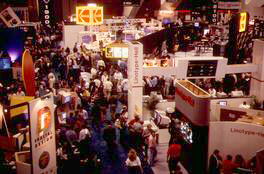Our Best CleanAir Presentation |
For company sales representatives, being on a trade show floor can be uncomfortable: You're surrounded on all sides by competitors and judged by browsing shoppers.
But it's also a prime sales tool for those who know how to grab hold of every potential opportunity. After all, the average trade show features 573 exhibiting companies where more than 14,000 professional attendees drop in to chat, according to industry statistics. There's no way you could cram that many appointments into a normal two or three-day period.
Getting Ready
 |
Collect Information in Exchange for Freebies
Trade shows often boil down to polite trick-or-treating parties for adults. Be sure that customers receive any rewards deep into a presentation. Handing out goodies upfront without asking for sales information earns you nothing. It can also be unproductive to ask people to fill out questionnaires before they receive free merchandise. Instead, ask for business cards at the end of conversations and ask for a good time to call. In exchange, hand the potential customer your own card and the incentive gift.Making the Pitch
Sometimes, salespeople unconsciously hand booth visitors the perfect reason to say "No" and walk on. Qualified leads escape, thanks to ice-breaker mistakes like "May I show you our product?" or "Do you air emission issues at your plant?"Instead, approach visitors as if you were sending him a piece of direct mail. Grab them with an intriguing thought about your product, like "Do you know why so many people are interested in Mercury/FTIR/Accurate Flow Measurement/etc?"
Other effective openers: "What are your main objectives for attending this show?" and
|
Follow-up questions should probe deeper into the potential customer's requirements: Are you happy with your current suppliers? What are your criteria for evaluation? What would you change about your current products or service?
When demonstrating our stuff, ask open-ended questions: What do you think of our service/product's performance? How can it help meet your needs? Make prospects pay attention to your advantages rather than drift through a canned speech.
Ask who else at the company participates in the decision-making process. Inquire about the time frame for purchase and give the customer a chance to divulge any additional information about his situation.
 Finally, don't be afraid to admit there might not be a match if you suspect the prospect is a dud or a spy for the competition. The sea of visitors passing your booth surely holds other qualified prospects. Spend your time fishing wisely.
Finally, don't be afraid to admit there might not be a match if you suspect the prospect is a dud or a spy for the competition. The sea of visitors passing your booth surely holds other qualified prospects. Spend your time fishing wisely.
